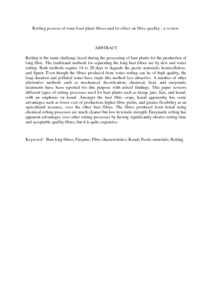Citation
Md. Tahir, Paridah and Basher, Amel and Osman Al-Edrus, Syeed Saifulazry and Ahmed, Zakiah
(2011)
Retting process of some bast plant fibres and its effect on fibre quality : a review.
BioResources, 6 (4).
pp. 5260-5281.
ISSN 1930-2126
Abstract
Retting is the main challenge faced during the processing of bast plants for the production of long fibre. The traditional methods for separating the long bast fibres are by dew and water retting. Both methods require 14 to 28 days to degrade the pectic materials, hemicellulose, and lignin. Even though the fibres produced from water retting can be of high quality, the long duration and polluted water have made this method less attractive. A number of other alternative methods such as mechanical decortication, chemical, heat, and enzymatic treatments have been reported for this purpose with mixed findings. This paper reviews different types of retting processes used for bast plants such as hemp, jute, flax, and kenaf, with an emphasis on kenaf. Amongst the bast fibre crops, kenaf apparently has some advantages such as lower cost of production, higher fibre yields, and greater flexibility as an agricultural resource, over the other bast fibres. The fibres produced from kenaf using chemical retting processes are much cleaner but low in tensile strength. Enzymatic retting has apparent advantages over other retting processes by having significantly shorter retting time and acceptable quality fibres, but it is quite expensive.
Download File
![[img]](http://psasir.upm.edu.my/23996/1.hassmallThumbnailVersion/Retting%20process%20of%20some%20bast%20plant%20fibres%20and%20its%20effect%20on%20fibre%20quality.pdf)  Preview |
|
PDF (Abstract)
Retting process of some bast plant fibres and its effect on fibre quality.pdf
Download (84kB)
| Preview
|
|
Additional Metadata
Actions (login required)
 |
View Item |

